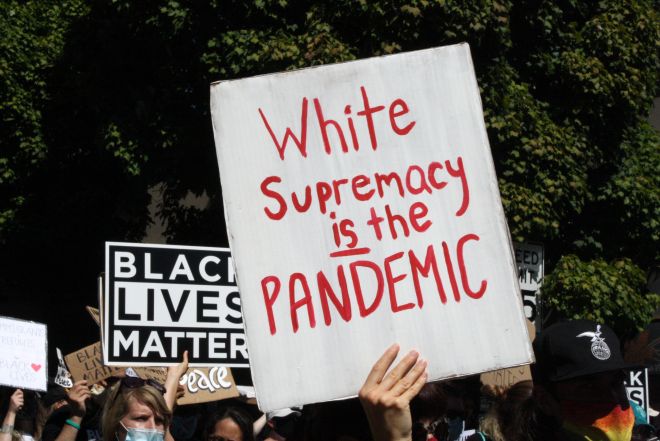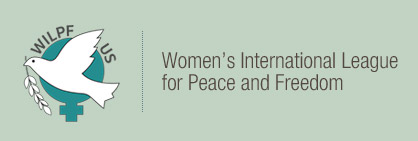WILPF US Racial Justice Work Part 2: Looking Out, Looking In
Published on September, 54 2021
By Darien De Lu
President
October 2021
Inner and Outer Work
These two areas of work, inner and outer, share broad goals; but the individual objectives along the way to those goals will differ. With inner work, we’re speaking to sympathetic WILPF members, with whom we share community. Our strategies for influencing them will likely differ from our approach with the public or politicians.
I see these distinct kinds of work as a good reason to do the work in different WILPF structures. For outer work, issue committees – which do many kinds of political work, often in similar ways, with similar audiences – are a suitable structure. For inner work, an ad hoc committee can be preferable, for the special task of addressing members and relating the work to WILPF.
In the Part 1 article – in the September eNews – I discussed the recent history of the Advancing Human Rights Committee, from 2017 to the present. I’ll look back at 1996-2016 in Part 3. Also, WILPF work on racial justice and anti-racism issues goes onward. In this article I’m applying the inner and outer distinction to facets of and directions for our current work, especially highlighting the particularities of each and what I see as the kinds of WILPF structures suited to working on them.
In Part 1, I described my sense of these two, both of which are important for WILPF. Inner work on anti-racism and related matters addresses various aspects of institutionalized white supremacy within the structures of WILPF US. Additionally, inner work operates on the personal level, to raise members’ individual l awareness and knowledge about the functioning of white supremacy and bringing to the foreground unconscious attitudes, and biases – especially racial biases, along with other biases about groups of people, such as related to age, gender identity, and economic class. Outer work confronts white supremacy in the US and in US government policies: race-related societal and structural injustices in education, employment, the law, etc.
WILPF’s purpose – ending war and all causes of war – is usually focused on political work, on the outer. Such work usually takes place through our issue committees and, sometimes, in special cross-cutting campaigns (such as our current Call for Peace). Yet to be a healthy organization and also to support cultural change, we also must also address the inner. That work stretches from the individual – recognizing white privilege and mico-aggressions – to the organizational – recruiting, welcoming, and supporting Black and other women of color and encouraging their leadership in WILPF.
Additionally, in order to be more welcoming to all kinds of possible WILPF members, the activities of an anti-racism committee doing inner work can help members and branches increase their awareness about and appreciation of “cultural” differences beyond race and ethnicity (such as economic class, gender-identity, and age). At a time when many forces seem to be driving people apart and creating separation, it is important to find ways to be more inclusive and welcoming. WILPF US will be a wiser organization when informed by a full range of liberation and justice perspectives. Valuing our different backgrounds and uniting our efforts, we’ll be stronger and more able to collaborate with other groups.
We can assume WILPF members want to better understand the myriad effects of white supremacy on our wider culture – from manufactured goods (like color choices in cosmetics) to the color of our armies, especially with the economic draft. We do want to support a personal culture of racial justice, founded on being more aware of how what we say and do is received by others – including how it offends and even harms other people. We, as WILPF, should be able to address our individual and our group short-comings in relation to Black, Latinx, Asian, and other indigenous and people of color.
Outer work speaks to a very different audience and set of circumstances, communicating in very different ways. Perhaps the emphasis for outer work may be more confrontational. What appeals to WILPF members as approaches for getting at the objectives – and what to politicians? to manufacturers and employers? to the public?
Looking Around, Looking In
With the first book-study group curriculum on Uprooting Racism by Paul Kivel, the educational foundation for both inner and outer anti-racism work has already begun (and branches and individuals can continue it in the future). (Kivel’s presentation at our August Congress is available here.) Also, we can all learn from videos, articles, books, and more included in the WILPF Resource List for Dismantling White Supremacy [Please include PDF link here: 02eNewsPt1ResourceList.pdf ] (over twenty pages of resources!). Additionally, over a year ago, WILPF’s Advancing Human Rights (AHR) Issue Committee started compiling a Resource Library of such items to support working toward racial and social justice.
If you would like to be part of an ad hoc committee to work on inner work – work that began with committee meetings through the summer and will continue, please contact me: President@WILPFUS.org. That committee will start with addressing WILPF members’ personal understanding of race matters, especially dealing with white supremacy.
As I mentioned above, ongoing outer work is most often done in issue committees. Currently, AHR is the likely home for anti-racism work, to address topics like reparations, the treatment of Haitian and Latin American immigrants, and voting rights. Contact Interim Convener, Joan Goddard, for more information: AHRChair@wilpfus.org.



